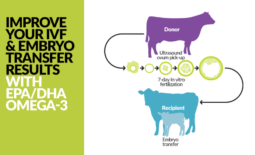Improving Preg Rate Beyond 30—Is it Worth It?
My reproduction is good enough! That phrase has come across my ears more times than I can count. I am always thrilled that the dairy has attained what they feel to be the necessary level of reproductive efficiency to maintain a profitable dairy, but I’m always left wondering “what is really good enough?” Have they made great progress and are simply taking time to focus on improving other areas of the dairy that are now the low hanging fruit? Or have they determined that there’s not much value in pursuing higher pregnancy rates? Or perhaps they feel that there’s little room to improve beyond the 30-preg rate that they’ve already obtained…that they’ve reached their herd’s reproductive pinnacle. While every situation is different, I’d like to offer up some current research and analysis that may help bolster, reinforce, or redirect your efforts for continued reproductive improvements.
Not So Diminishing Returns
In the early 2000’s, the work by Dr. Mike Overton (and later repeated by Cabrera and others) seared in my mind that the value of improving pregnancy rate was one of diminishing returns (figure 1). The value of improving from a 20% to 25% pregnancy rate was far greater than moving from 25% to 30%. While that is still some truth in that today…the incremental value is less for those higher-level improvements…there is still significant value from achieving higher pregnancy rates (e.g. 40 % PR). In fact, the broad use of sexed semen technology coupled with beef on dairy begs for these economic models to be updated. Today, every time a heifer or cow does not get pregnant the first time, the result is fewer $700 beef calves to sell…leaving significant opportunity cost on the table with every failed pregnancy.

Impact of Higher Calf Values
To test my assumptions, I turned to Dr. Cabrera’s “Value of Reproductive Improvement” tool on the University of Wisconsin’s website to help run some scenarios. The base scenario is for a 3000-cow high producing herd: 30,000 RHA, $0.16/lb dry matter feed cost, $18/cwt milk price and reproductive cost/cow/month at $50. The two variables that I ran were pregnancy rate and calf values: 5-point pregnancy rate improvements (from 25 to 30, 30 to 35 and 35 to 40), with Holstein bull calf price at $250 or Beef cross calves at $700 per head.
Running these simple scenarios, I came away with a few conclusions. #1: While the value of improving reproduction tends to decline as you reach higher pregnancy rates, there’s still tremendous value to capture. And #2: Higher beef calf prices raise the value across the board…wherever you are at today, there’s more incentive to improve reproduction than there was at lower calf prices. Lastly, what this tool does not incorporate is the value of creating your next generation from a smaller pool of your most elite genetics…that greater selection opportunity is the X factor that may make reaching for the big 4-0 more valuable than your earlier incremental gains.

*Modeled with University of Wisconsin’s Dairy Management Tool
Is 40 Pregnancy Rate Attainable?
Now that we’ve walked through the math of what’s to gain from improving pregnancy rate, let’s step back to answer this question: Is reaching a 40+ pregnancy rate is even attainable? While the advances in reproductive protocols, such as double ovsynch, have created a leap in both heat detection rate and conception rates, there’s still lots of other reasons to believe that 40+ pregnancy rates are attainable for many (not just for a few!).
- Research from University of Guelph shows that a whopping 83% of eggs are fertilized at day one post ovulation, and that by day six, the percent viable embryos has dropped to 67% on average (figure 3). If your herd’s conception rate is hovering around 40%, then you’ve lost potentially 50% of the embryos that were fertilized at day one. Some may think that is bad news, but I think it is great news…the cow has shown that she is fertile, and we have the challenge of removing the barriers to help her simply stay pregnant.
- Since fatty acids are my forte, I’ll share one example in the fatty acid literature of small changes in nutrition that can make a substantial difference in embryo development and retention. Research by Oseikria 2016 with DHA omega-3, an essential fatty acid for embryo development, showed that when .45 gram was added during IVM, the day 7 blastocyst growth rate doubled…that rate is just a fraction of what has historically been fed on dairies. A follow-up feeding study (Figure 4 – Freret 2019) at low levels was performed that showed similar results, with an increase in blastocyst growth rate and a 29% increase in good quality/freezable embryos.
- Lastly, the continued work from the University of Florida on the effects of heat stress on dry cows, in-utero daughters and granddaughters is reason enough to believe there’s more we can do to improve pregnancy maintenance. The quick recap is this: not cooling cows during the dry period is profoundly altering reproductive health in your herd…directly impacting in-utero calf reproductive development, as well as that of the dam’s granddaughters (an in-utero female calf has all the eggs she’ll ever have before she’s even born!).
My hope is that this discussion has reinvigorated your focus on achieving greater reproductive performance. Reproduction has always been front and center in managing for a highly profitable herd, driving greater herd productivity and feed efficiency. With the advent of sexed semen and beef cross strategies, the incentives for great reproduction have been elevated. Our challenge is to seek out ways to improve both management and nutrition to support what we’ve genetically built our herds to do.









